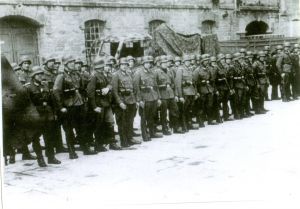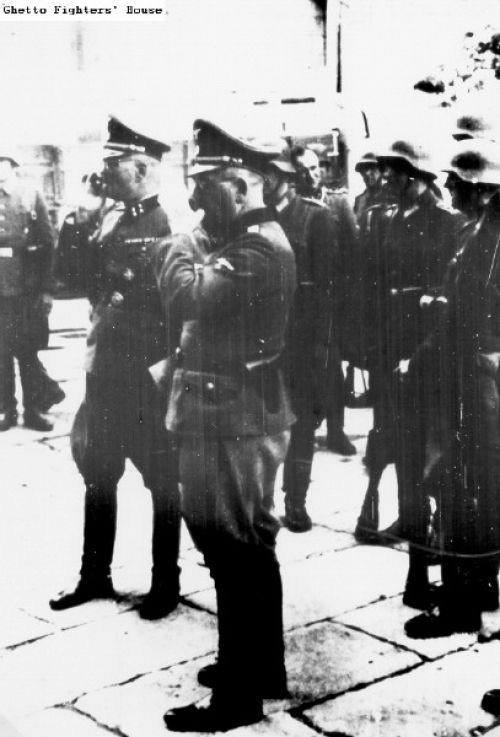San Sabba Police Camp in Trieste

SS Group in San Sabba, Otto Stadie front row far left
The large complex of buildings making up the rice husking factory constructed in 1913 in San Sabba on the outskirts of Trieste was first used by the Nazis as a temporary prison camp for the detention of Italian servicemen captured after the 8 September 1943. It was designated Stalag 339 but in late October 1943 it was converted into a Polizeihaftlager (Police detention camp) to be used as a transit camp for deportees bound for Germany and Poland, for the storage of confiscated property and for the internment and execution of hostages, partisans, political prisoners and Jews.
The first room on the left in the underground entry passage was known as the “death cell.” In the “death cell” were kept internees transported from prisons or captured in round-ups and earmarked for execution and cremation within a short time, and indeed according to eye-witness accounts new arrivals in the “death cell” often found themselves sharing the cell with the bodies awaiting cremation. On the left side of the ground floor of the three- storey building housing the dressmaking and shoe-making shops where prisoners worked and quarters for the SS officers and other ranks were seventeen mini-cells which could house six inmates in each cell. These cells were set aside mainly for partisans, political prisoners and Jews scheduled for execution in the space of a few days or sometimes weeks. The first two cells were used for torture or the collection of property confiscated from the prisoners.
The articles found there included thousands of identity cards taken from prisoners, deportees and individuals sent for forced labour, these were found by Yugoslav troops. The next building four storeys high, was made up of large rooms used for the detention of Jews, other civilian prisoners and prisoners-of –war mostly destined for deportation to the Reich – men, women, children and babies were transported to concentration camps such as Auschwitz, Dachau and Mauthausen, where most perished. In the inner courtyard, opposite the cells was the building housing the oven in which bodies were cremated, the oven, built below ground level was reached by means of a stair. An underground passage joined the oven to the chimney stack. After using the existing rice-drying facility from January to March 1944, the Germans converted it into a crematorium capable of incinerating a large number of bodies. The plan was drawn up by Erwin Lambert, who was the Aktion Reinhardt construction expert, who had built gas chambers at the Sobibor and Treblinka death camps, and euthanasia killing centres in the Reich. The cremation facility was tested on the 4 April 1944 with the cremation of the bodies of seventy hostages shot the day before at the Opicina shooting range. On the night of 29 April 1945 the building housing the crematorium and the chimney stack connected to it were dynamited by the fleeing Germans, who were trying to remove the evidence of their crimes.

Wirth and Hering in San Sabba
The Germans killed their prisoners in a number of ways - gassings were carried out in specially converted vehicles, blows with a club to the base of the skull and shootings. The Germans revved engines of vehicles and played music to smother the sound of the executions. The central building, six storeys high was used as barracks, on the upper floors were quarters for German, Austrian, Ukrainian and Italian SS troops, while the lower floor housed the kitchens and mess. The building which is now a chapel was used as a garage for the SS vehicles stationed there, including the black vans with exhausts connected to the inside, used to gas some of the inmates. The small building outside the complex on the left was the guardhouse and Commandant’s quarters. On the right was a three storey building with offices, NCO’s quarters and accommodation for the Ukrainian women.
Policing, political and racial repression and anti-partisan operations were under the control of the SS commanded by Odilo Globocnik, Hohere SS und Polizeiführer AdriatischesKustenland, who had been born in Trieste on the 21 April 1904. Globocnik was appointed by Himmler to oversee the mass murder of Polish Jewry known as Aktion Reinhardt, when the death camps were dismantled, he brought to Trieste a large number of brutal experienced killers and staff members who had served in Belzec, Sobibor and Treblinka.
A few days after 8 September 1943 Christian Wirth, one of Globocnik’s right hand men arrived in Trieste, with him were some of the personnel who had served in the euthanasia killing centres of T4, and the Aktion Reinhard death camp’s. This Einsatzkommando was divided into three geographical areas, the headquarters for each was officially denoted with a variation of the letter R:
R1 – Trieste
R2 – Udine
R3 – Fiume
Christian Wirth was in charge of the first Einsatzkommando in Trieste, after his death in a partisan ambush near Kozina Istria on the 26 May 1944, he was replaced by Dieter Allers. His right- hand man and Commandant of the Risera was Josef Oberhauser.
In Trieste in April 1976, over thirty years after the tragic events outlined above, a trial was completed of some of those responsible for the crimes committed in San Sabba. Josef Oberhauser was tried in absentia, and was found guilty of war crimes and sentenced to life imprisonment, but the Italian authorities did not request his extradition and he died on 22 November 1979 at the age of sixty-five. The Risiera in San Sabba complex was converted into a museum which opened in 1975
Sources
Risiera di San Sabba published by Comune Di Trieste
Photographs – Ghetto Fighters House, Israel
© Holocaust Historical Society 2019



